Dazzled by bright sunshine our group gathered for our first introduction to the wonders of the trade route in Uzbekistan. Despite an overnight flight and time difference, we were keen to explore Tashkent; first stop the Khast Imam complex housing one of the original seven copies of the Koran, with giant’s writing on animal skin, brought originally by Emperor Tamerlane in the 14th Century to Samarkand. With turquoise domes and mosaics shimmering in the sunlight, the architecture was just a tiny fragment of what was to come in the next 10 days.
The imposing modernity of the monument to the devastating 1966 earthquake, the bustling Chorsu Bazaar and the surprises of a Tashkent underground station decorated with images of astronauts/cosmonauts were a lively contrast to our first introduction to the mosques, madrasas and mausoleums along the Silk Road, and to the friendly Uzbekistan people.
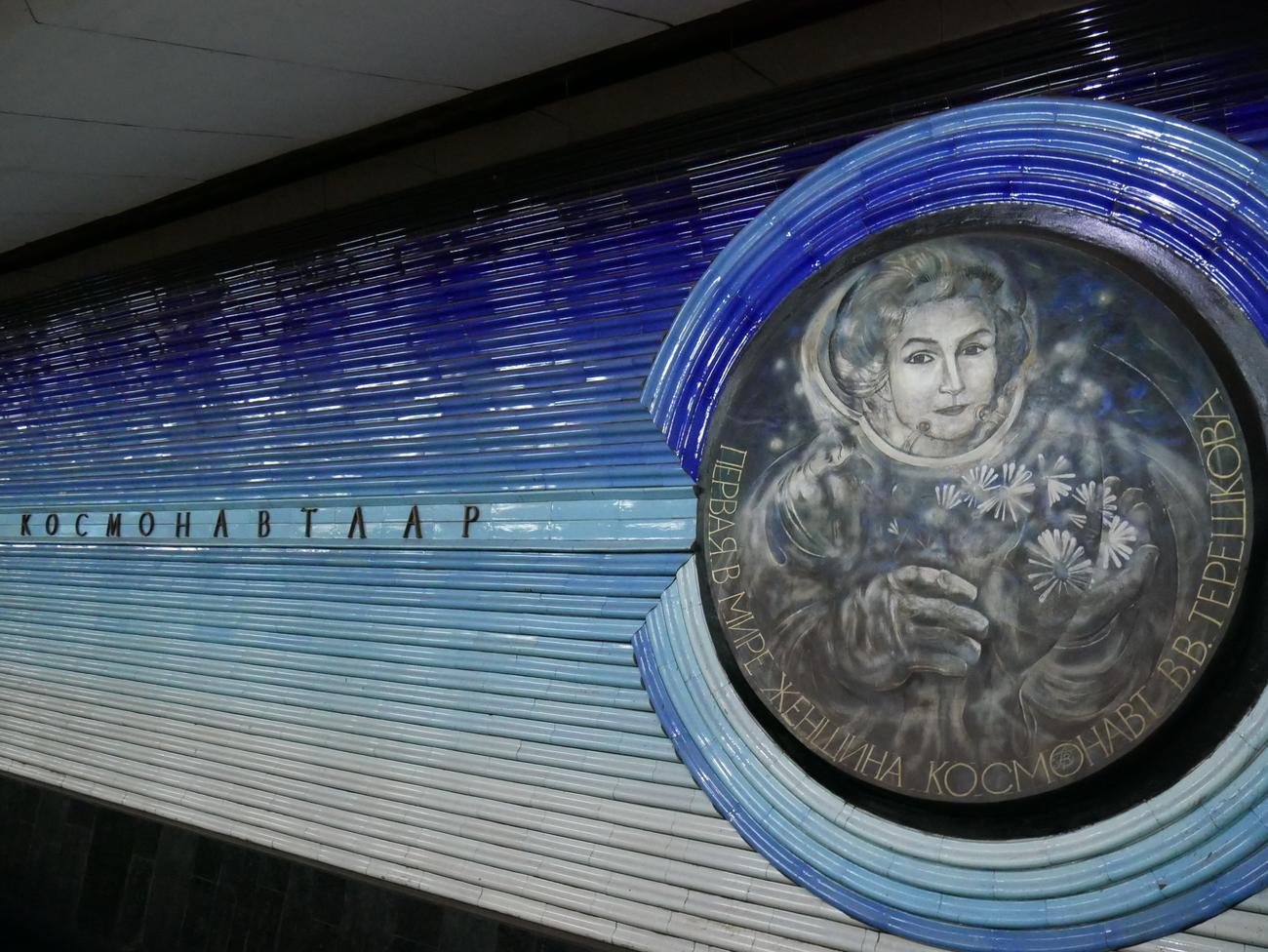
Our arrival to Khiva coincided with the visit of the Russian Prime Minister and the President of Uzbekistan who had chosen to visit Khiva at the same time as our group. Our hotel, the converted Mohammed Amin Khan Madrasa, was part of a backdrop to a traditional dance display where we came across members of the dance troupe waiting in the heat, wearing traditional astrakhan hats and thick boots. Lots of mutual fascination and conversations without words ensue – my long blonde hair attracts lots of friendly attention, and I find myself being photographed just as often as I am photographing the architecture.


Staying in the old madrasa built in the mid-1800s and forming part of the old city walls is one of the most memorable parts of the trip. The colours of the Kalta Minor (short minaret) outside the main hotel entrance seem to change with the light and I often sit on the low wall at the entrance to the madrasa gazing at the blue and turquoise colours of the mosaics on the Kalta Minor at different times of the day as the light changes. In the early evening, swifts swoop around the tower at high speed and nest above the hotel door.
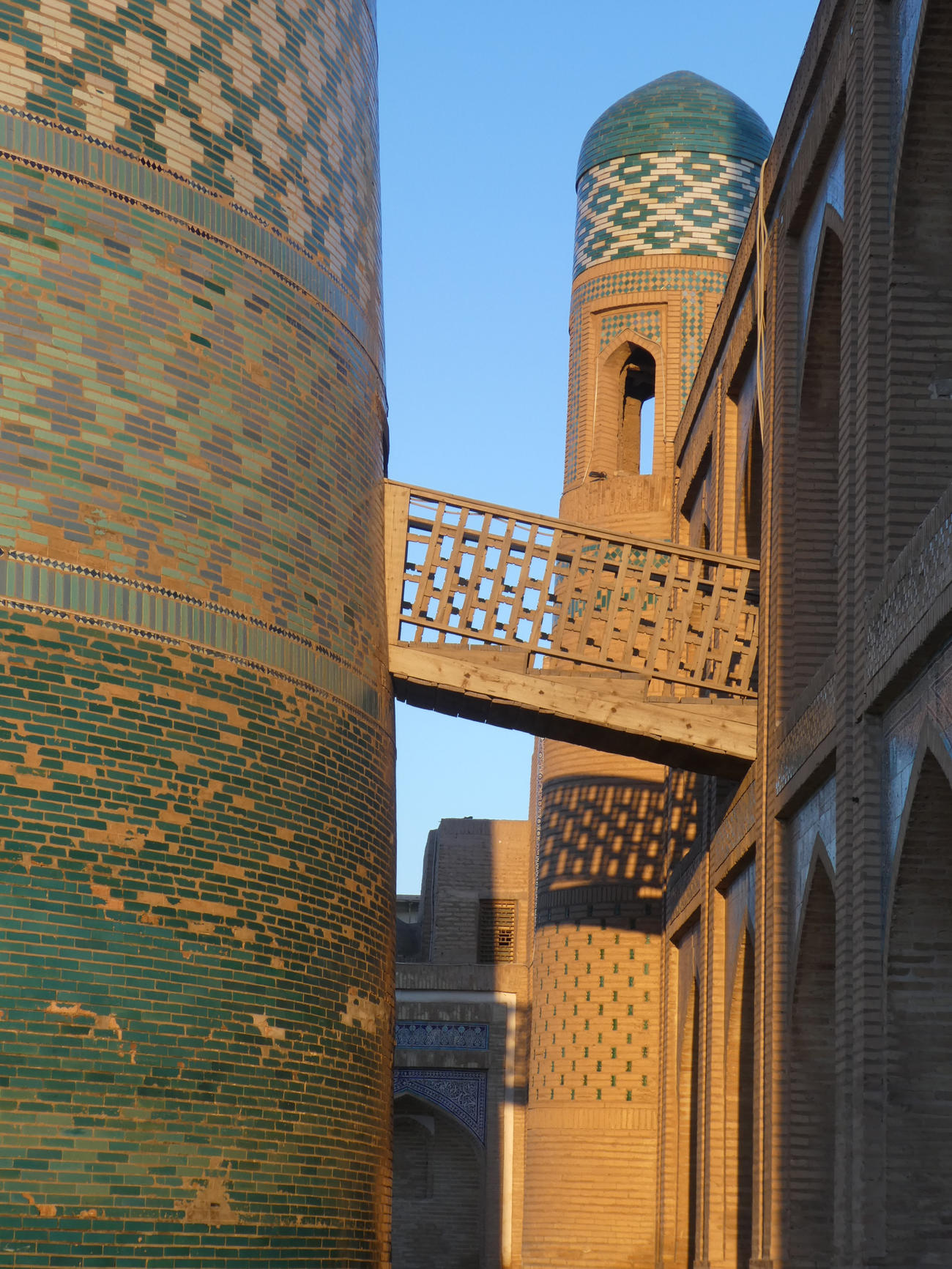

The old walled city of Khiva, the Ichan Qala, is teeming with over 50 historic buildings. I’m reminded of the medinas of North Africa, especially Marrakech, but everywhere is spotlessly clean, calm and peaceful, and there’s no call to prayer - or palm trees! It feels familiar but strikingly unfamiliar at the same time.
Too soon we leave Khiva and continue to Bukhara, in the safe hands of our driver along very bumpy roads, with plentiful information from Alisher our local guide, and the calming presence and kindness of Max who makes sure everyone has ample supplies of water and that mislaid items are reunited with their owners. Even the countryside appears blue and turquoise as we drive through the Kara Kum desert close to the Rived Oxus and the border with Turkmenistan, at the shady lunch stop a hoopoe parades about, and we pass men on donkeys herding flocks of sheep and goats.

Bukhara brings more incredible blue and turquoise architecture, and we learn more about the Zoroastrian and Persian influences on the tile patterns. There are not only the geometric patterns permitted in Islam but also flowers and dramatic birds decorating the 17th Century madrasa.
The town is bustling with families strolling around in the early evening and sitting at outdoor cafes around a pond with fountains around its edge and the statue of Nusraddin, the 13th Century wise-man folk storyteller, who is known throughout the Middle East, South and Central Asia.
With no common language, other than my confident ‘salaam a lakum’ greeting and a big smile whenever someone smiles at me, I am persuaded by a group of women and children to try popcorn cooled with dry ice and experience the strange sensation of dry-ice ‘smoke’ coming out of my nose and mouth, leading to great hilarity, more photographs of me, and hugs all round. I’m enjoying these frequent good-humoured encounters with Uzbek people.
In the Samanids Mausoleum the next day I sit quietly and peacefully, and a local family comes to sit with me, as a pilgrim sings koranic verses. I’ve missed hearing the call for prayer and this fills my senses, in the fabulously-tiled cool interior among peaceful friendly people. I’m transported back to so many positive experiences in the Islamic countries of North Africa.
I buy postcards at the mosque and meet another photographer who understands the importance of symmetry, as without words being needed he opens some heavy doors a fraction more to create balance for my photographs. The scale of the architecture has increased enormously since Khiva and there’s a subtle difference in the colours and patterns.
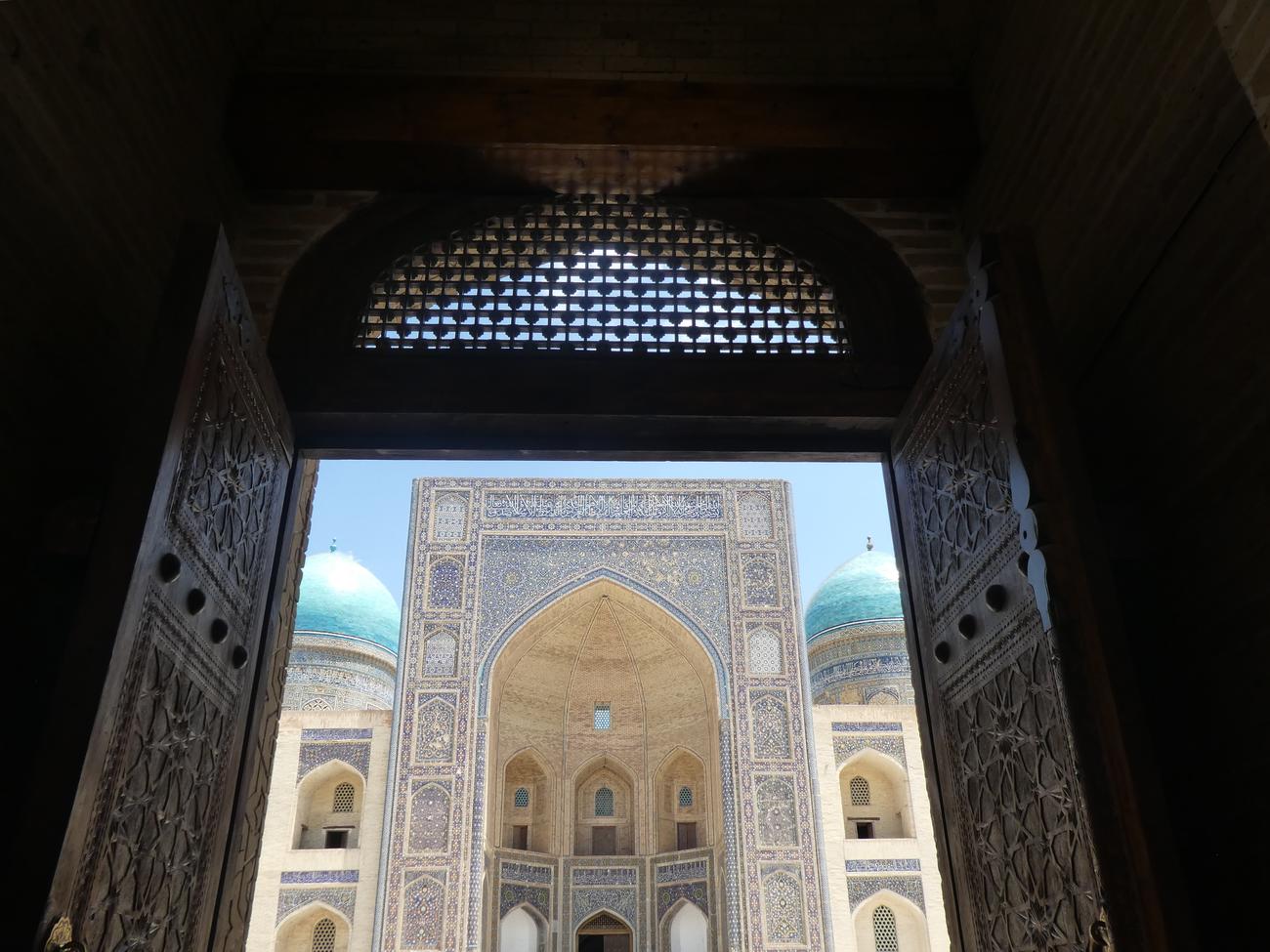
Visiting a hand-made carpet workshop we take shelter from the heat to learn how silk thread is died and woven into exquisite silk heirloom carpets; the most expensive, known as magic carpets, take two young women two years to weave, each weaving a different pattern to create a reversible luxurious carpet. The prices are beyond my reach, but I imagine how the pomegranate red one would look in my dining room.
Later, a few of us take a stroll with Max through a residential area to the diminutive and quirky Chor Minor mosque with towers at each of the four corners, like an up-ended chair, and a pretend stork in a nest on the top of one of them. Unexpected discoveries provide glimpses into everyday life, and we come across a stall selling old Russian memorabilia, mulberry fruit spread out to dry, and men picking what they tell me are apricots from a tree and they offer me one to taste.
In the morning we head off to the mountains, to homestay accommodation, in the Nuratau eco-reserve. We are all looking forward to a change of pace and altitude. Our long bumpy journey is punctuated by lunch with a local family in their garden with rose bushes, and a colourful pet bird.


Those of us who did not succumb to falling asleep en-route are rewarded by seeing a huge eagle and a vulture and I was lucky to see a marmot run across the road. We take a detour as the mountain pass is closed for road improvements, allowing more time to absorb the scenery from the windows of our transport.
The homestay is simple, as we had expected, and reached by a steep track which crossed a rocky stream. We are greeted by the extended family and soon enjoy a hearty meal. Our rooms are by a gurgling stream, surrounded by a vegetable plot. The children play in the stream supervised by grandmother, a huge friendly dog has given up trying to keep the flies at bay and an astrakhan lamb continually manages to tangle itself in its tether rope.
Some of us are keen to explore the next day while others enjoy a quiet morning relaxing by the stream, and led by our host we visit a family of silkworm farmers upstream, stopping on the way to see petroglyphs carved, as legend says, by Alexander the Great’s army who took shelter on the mountains to hunt deer and be revived by mountain streams, over 300 years BC. As the adults show us the bunches of silkworms feeding on vegetation, the small children re-enact the story of how a 13th Century Chinese princess, married to an Uzbek Khan, hides silk cocoons in her elaborate hairstyle as she cannot imagine life without the luxury of silk clothes – by gently placing silkworm cocoons in my hair.
Undaunted by the possible change in the weather coming, and packing waterproofs in our day sacks just in case, a small group of us, led by our host and accompanied by our local guide and Max, set off to walk higher on the mountain. The forecast proves inaccurate and the weather remains scorching hot. We see flocks of astrakhan sheep, huge insects, clouds of orange butterflies, beautiful tall mountain asphodel flowers, wild rhubarb and extensive views to Lake Aydarkul. I feel myself overheating but we eventually reach the cold mountain stream in the valley, which we wade into up to our ankles.
Coming out of the shower later (without my camera) I’m met with a commotion as a very large snake was near the door. It looked to me like an enormous slow-worm and this was confirmed by our host and the local guide as a ‘good snake’ and I watched enthralled as it slowly disappeared into a hole in a wall.


Next morning we’re sad to leave the simple mountain life and our hospitable host family behind, but we have the promise of even more impressive architecture and rich history in the legendary Samarkand.
Our knowledge of traditional artisan crafts continues to be added to, with a brief stop at a handmade mulberry paper workshop where we learn about the process and I buy sheets of blue mulberry paper, intending to create some chine-collé linoprints inspired by this incredible journey when I return home.
The weather is cloudier today and I’m aware how lucky we’ve been so far to have bright blue skies against which to see the blue, white and turquoise architecture at its best.
The magnificent Registan Square is busier than we’ve seen other places – but not at all crowded. It’s the end of Ramadan and many people are visiting this special place. The fluted turquoise domes shimmer in the sunshine as the clouds disperse. The 17th Century mosaics depict what might be a lion or tiger, with a sun-like face behind it, diverging from the traditional geometric patterns of Islamic architecture as it is influenced by Persian Zoroastrian traditions that pre-date Islam. The scale is enormous, and photographs fail to capture the awe-inspiring size.
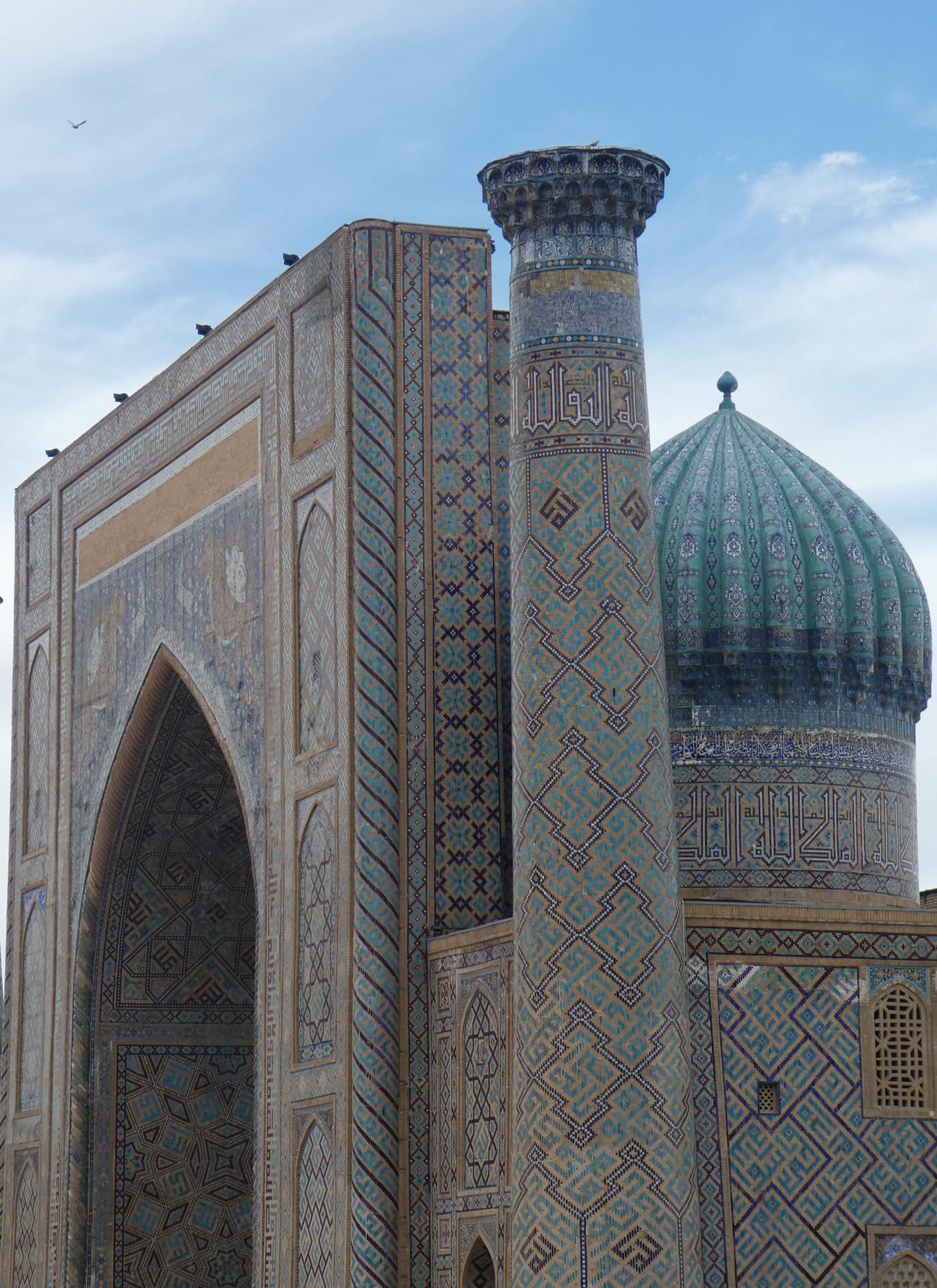
When I’m convinced I’ve already seen more turquoise wonders of the world than I ever thought possible, we reach the top of the steep entrance stairs of the 11th and 12th C Shah-i-Zinda complex and unusually I find myself totally lost for words and stand completely still, awestruck and captivated, struggling to absorb the intensity of the colours. In striking contrast to the impressive open space and grandeur of the Registan, we are in a narrow street-like complex with buildings either side and ahead. It is dizzyingly turquoise.
There are a few tourists but mostly local people, and before we leave I sit peacefully on a shaded bench under an ornate painted ceiling and elegant pillars listening intently as the Iman sings verses and blesses pilgrims, including one woman who spreads out a carrier bag full of household items and some small children to be blessed.
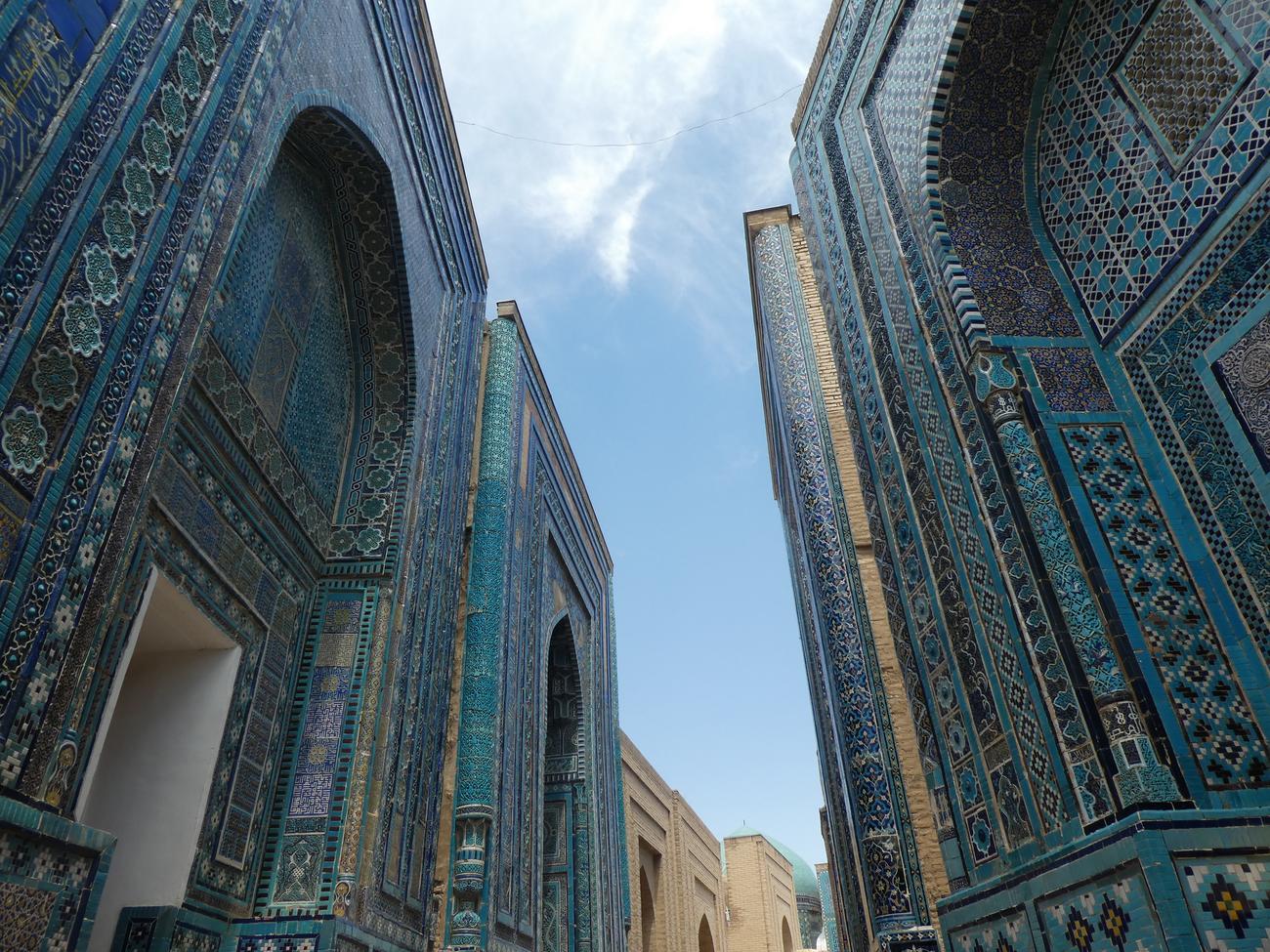
The 15th Century Bibi-Khanym mosque, built for the Khan’s favourite wife, has not been fully restored yet despite grass growing on the domes it still looks magnificent.

At Tamerlane’s mausoleum, the ornate entrance leads to a surprising gold interior and the dazzling mosaics challenges both my cameras as I experiment with settings, kneel down and lean back to capture the golden symmetry.


Inspired by our lunch cooked by a local family and eaten in their courtyard, some of us buy spices in the Siyob Bazaar to recreate the national dish of Plov – rice, meat, carrots and onions - which was served with quails eggs delicately balanced on top.
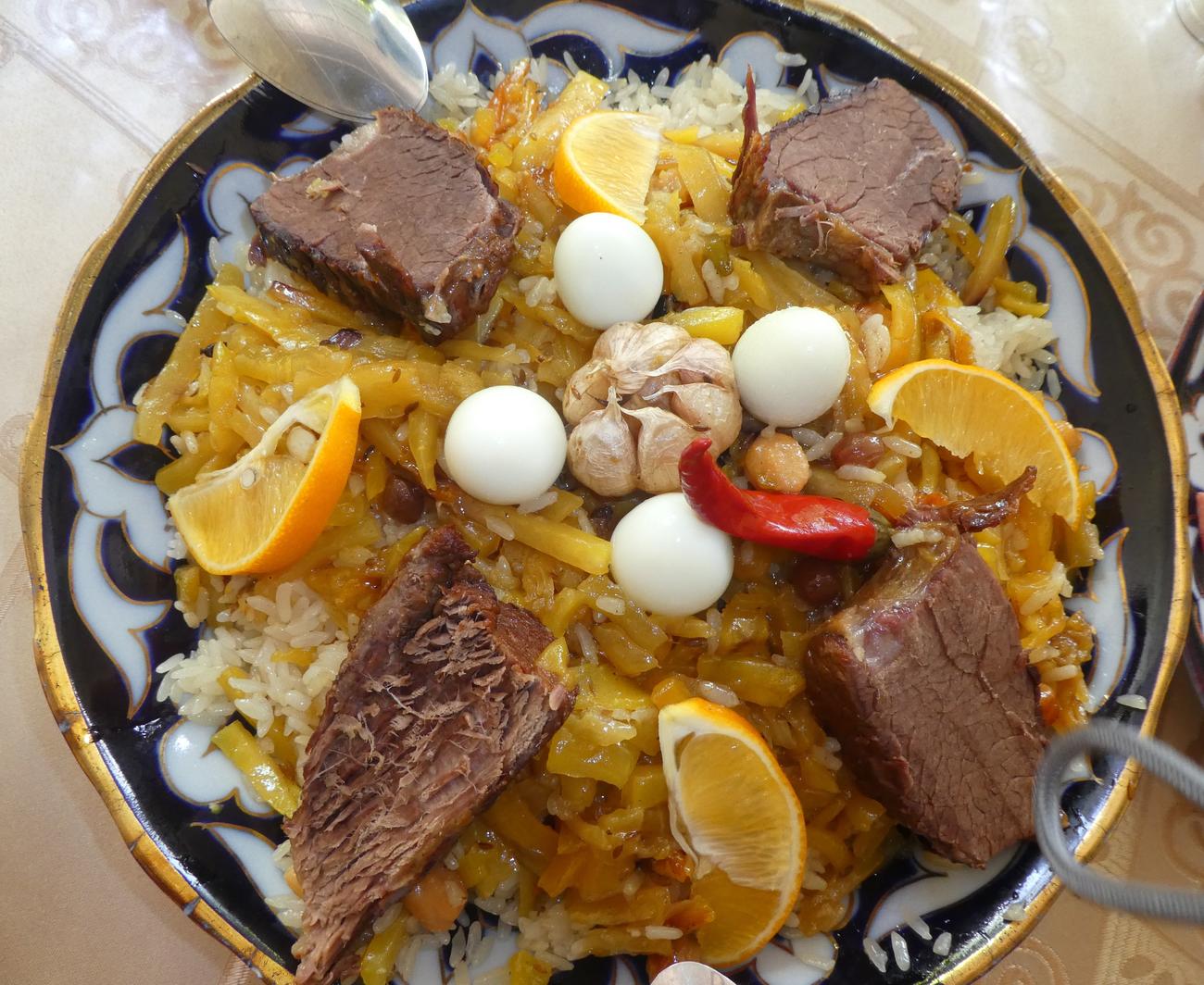
Our final evening meal is in a restaurant where there’s a party going on upstairs with Abba’s Dancing Queen being played loudly. When my curiosity gets the better of me I’m lured into the party and pulled on to the dance floor by some young women - the fun lasts only for a few minutes as everyone else had gone out to our awaiting bus and I have to reluctantly dash off like Cinderella.
The trip is over too quickly and the long drive to the airport is a final chance to capture memories on the camera as the countryside whizzes by. We stop briefly at the gap in the cliffs where Alexander the Great is said to have travelled through, we see yurts being used as homes for construction workers, and with my camera on a very fast shutter speed I’m delighted to capture storks on their nests - real ones this time as they have built many nests high up on telegraph poles!

We make sure we have the right number of handwritten paper receipts in our passports issued at every place we have stayed, which Max has safely looked after for us; check no-one has left anything on the bus; thanked and said goodbye to our local guide Alisher who has helped us to understand and appreciate this amazing country, and our driver; and finally to Max who has looked after us, shared his knowledge and respect for not only Uzbekistan, and who been a fantastic travelling companion.
Having been lured away from North Africa as my go-to place, I just might book a trip to Kyrgyzstan for my next adventure to spend more time getting to know the local people and spending time in the intriguing Tien Shan mountains.
